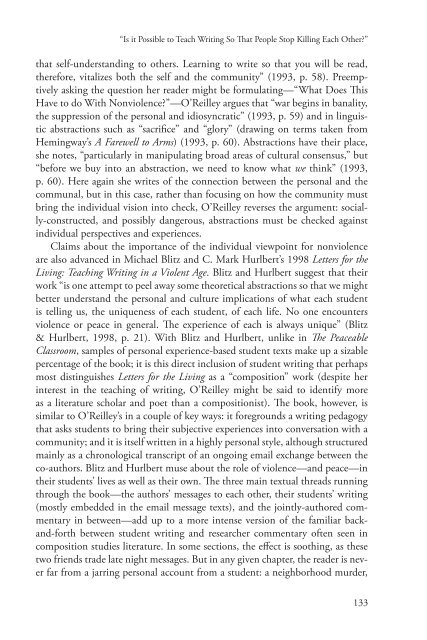Critical Expressivism- Theory and Practice in the Composition Classroom, 2014a
Critical Expressivism- Theory and Practice in the Composition Classroom, 2014a
Critical Expressivism- Theory and Practice in the Composition Classroom, 2014a
You also want an ePaper? Increase the reach of your titles
YUMPU automatically turns print PDFs into web optimized ePapers that Google loves.
“Is it Possible to Teach Writ<strong>in</strong>g So That People Stop Kill<strong>in</strong>g Each O<strong>the</strong>r?”<br />
that self-underst<strong>and</strong><strong>in</strong>g to o<strong>the</strong>rs. Learn<strong>in</strong>g to write so that you will be read,<br />
<strong>the</strong>refore, vitalizes both <strong>the</strong> self <strong>and</strong> <strong>the</strong> community” (1993, p. 58). Preemptively<br />
ask<strong>in</strong>g <strong>the</strong> question her reader might be formulat<strong>in</strong>g—“What Does This<br />
Have to do With Nonviolence?”—O’Reilley argues that “war beg<strong>in</strong>s <strong>in</strong> banality,<br />
<strong>the</strong> suppression of <strong>the</strong> personal <strong>and</strong> idiosyncratic” (1993, p. 59) <strong>and</strong> <strong>in</strong> l<strong>in</strong>guistic<br />
abstractions such as “sacrifice” <strong>and</strong> “glory” (draw<strong>in</strong>g on terms taken from<br />
Hem<strong>in</strong>gway’s A Farewell to Arms) (1993, p. 60). Abstractions have <strong>the</strong>ir place,<br />
she notes, “particularly <strong>in</strong> manipulat<strong>in</strong>g broad areas of cultural consensus,” but<br />
“before we buy <strong>in</strong>to an abstraction, we need to know what we th<strong>in</strong>k” (1993,<br />
p. 60). Here aga<strong>in</strong> she writes of <strong>the</strong> connection between <strong>the</strong> personal <strong>and</strong> <strong>the</strong><br />
communal, but <strong>in</strong> this case, ra<strong>the</strong>r than focus<strong>in</strong>g on how <strong>the</strong> community must<br />
br<strong>in</strong>g <strong>the</strong> <strong>in</strong>dividual vision <strong>in</strong>to check, O’Reilley reverses <strong>the</strong> argument: socially-constructed,<br />
<strong>and</strong> possibly dangerous, abstractions must be checked aga<strong>in</strong>st<br />
<strong>in</strong>dividual perspectives <strong>and</strong> experiences.<br />
Claims about <strong>the</strong> importance of <strong>the</strong> <strong>in</strong>dividual viewpo<strong>in</strong>t for nonviolence<br />
are also advanced <strong>in</strong> Michael Blitz <strong>and</strong> C. Mark Hurlbert’s 1998 Letters for <strong>the</strong><br />
Liv<strong>in</strong>g: Teach<strong>in</strong>g Writ<strong>in</strong>g <strong>in</strong> a Violent Age. Blitz <strong>and</strong> Hurlbert suggest that <strong>the</strong>ir<br />
work “is one attempt to peel away some <strong>the</strong>oretical abstractions so that we might<br />
better underst<strong>and</strong> <strong>the</strong> personal <strong>and</strong> culture implications of what each student<br />
is tell<strong>in</strong>g us, <strong>the</strong> uniqueness of each student, of each life. No one encounters<br />
violence or peace <strong>in</strong> general. The experience of each is always unique” (Blitz<br />
& Hurlbert, 1998, p. 21). With Blitz <strong>and</strong> Hurlbert, unlike <strong>in</strong> The Peaceable<br />
<strong>Classroom</strong>, samples of personal experience-based student texts make up a sizable<br />
percentage of <strong>the</strong> book; it is this direct <strong>in</strong>clusion of student writ<strong>in</strong>g that perhaps<br />
most dist<strong>in</strong>guishes Letters for <strong>the</strong> Liv<strong>in</strong>g as a “composition” work (despite her<br />
<strong>in</strong>terest <strong>in</strong> <strong>the</strong> teach<strong>in</strong>g of writ<strong>in</strong>g, O’Reilley might be said to identify more<br />
as a literature scholar <strong>and</strong> poet than a compositionist). The book, however, is<br />
similar to O’Reilley’s <strong>in</strong> a couple of key ways: it foregrounds a writ<strong>in</strong>g pedagogy<br />
that asks students to br<strong>in</strong>g <strong>the</strong>ir subjective experiences <strong>in</strong>to conversation with a<br />
community; <strong>and</strong> it is itself written <strong>in</strong> a highly personal style, although structured<br />
ma<strong>in</strong>ly as a chronological transcript of an ongo<strong>in</strong>g email exchange between <strong>the</strong><br />
co-authors. Blitz <strong>and</strong> Hurlbert muse about <strong>the</strong> role of violence—<strong>and</strong> peace—<strong>in</strong><br />
<strong>the</strong>ir students’ lives as well as <strong>the</strong>ir own. The three ma<strong>in</strong> textual threads runn<strong>in</strong>g<br />
through <strong>the</strong> book—<strong>the</strong> authors’ messages to each o<strong>the</strong>r, <strong>the</strong>ir students’ writ<strong>in</strong>g<br />
(mostly embedded <strong>in</strong> <strong>the</strong> email message texts), <strong>and</strong> <strong>the</strong> jo<strong>in</strong>tly-authored commentary<br />
<strong>in</strong> between—add up to a more <strong>in</strong>tense version of <strong>the</strong> familiar back<strong>and</strong>-forth<br />
between student writ<strong>in</strong>g <strong>and</strong> researcher commentary often seen <strong>in</strong><br />
composition studies literature. In some sections, <strong>the</strong> effect is sooth<strong>in</strong>g, as <strong>the</strong>se<br />
two friends trade late night messages. But <strong>in</strong> any given chapter, <strong>the</strong> reader is never<br />
far from a jarr<strong>in</strong>g personal account from a student: a neighborhood murder,<br />
133


















